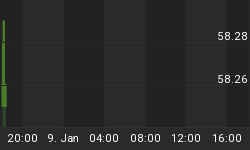Much has been made recently about the "negative gold lease rates" derived from the London Bullion Market Association (LBMA) statistical gold and silver data, but reporting on the issue so far has generally lacked the background, substance and/or context required for many readers to even understand what information is being provided much less draw proper conclusions.
Here are some of the key points raised in our extensive analysis of the subject at Metal Augmentor:
(1) The combination of a falling gold price and rising forward rate is quite a bullish feature of the gold market that is lost in the reporting on negative gold lease rates. An increase in the gold forward rate indicates that owners selling gold will want it back once their immediate funding needs have abated. Therefore it is really the reluctance to sell gold outright that the market appears to be telegraphing via negative gold lease rates. This is a welcome change from a gold market recently dominated by weak-handed participants (Wall Street types like Paulson, Cramer, etc.) who primarily look to gold for its ability to generate speculative profits during periods of economic instability.
(2) The gold (or silver) lease rate does not necessarily represent the actual rate at which lease transactions are being done in the market. The published lease rate is simply an indicated value derived from two related variables, the gold forward rate and LIBOR. These rates can and do move in opposite directions for reasons unrelated to gold leasing activity.
(3) We believe the focus on negative lease rates misses the point of the current gold market structure and instead we should be looking at changes in the gold forward rate. The gold forward rate has increased during both the late September and current sell-offs in gold, which probably means that gold is being leased by central banks in order to provide liquidity for the banking system. Importantly, central bank gold is probably not being sold outright despite rumors to the contrary. The implication is that the current gold correction is similar to past events where gold has been used as a liquidity management tool. Its use for such purposes is hardly inappropriate -- after all, gold is the ultimate money and what good is money if it doesn't get used? In any case, the eventual reversal of gold funding activity should correspond with improved commercial bank liquidity and a return to gold's dominant price uptrend.
(4) Important structural changes in the financial sector could soon mean that gold's widespread use as collateral and eventually as money might actually not be that far off. If so, it would only be a natural progression for an asset with no counterparty risk in a post-credit-bubble world. Excessive leverage has transformed even the gold swap and leasing business, which by definition is supposed to involve physical metal, into a paper form a
number of years ago. While the recent reports from Bloomberg, Financial Times and elsewhere offer shreds of truth about this condition amid all their misdirection, they fail to examine underlying developments in the gold market that may change the sorry state of affairs. Among the most intriguing is the possible development of clearing and collateral facilities for 100% physical backed gold, perhaps in the format of the LBMA unallocated bullion account.
We suspect that all this talk about "negative gold lease rates" may represent the initial glimmer of recognition that a major development is afoot in the gold market. Pieces of the puzzle are being put together without most people really knowing or understanding what the completed picture looks like. The general trend of the financial markets thanks to the information age has been to move away from intermediation and toward self-directed transaction. The tri-party arrangement redefines the role of the intermediary so that it is no longer the matchmaker between customers but rather acts as a clearing agent, administrator of collateral and a funding backstop.
Importantly, in a tri-party arrangement one party posts the collateral that the other party desires. And that desire for specific collateral is where things could get interesting for the gold market with gold being the ultimate collateral. In essence the selective collateral nature of the tri-party format may force bullion banks to eventually declare their unallocated LBMA gold accounts as backed by 100% physical bullion. While there certainly will be gold appearing on the market from time to time in the form of gold leasing or similar funding arrangements, the 300 year history of archaic bullion banking may be coming to an end. If so, it could ironically be ![]() JP Morgan that modernizes the gold standard by establishing gold as the premier monetary asset with no counterparty risk and infinite mobility.
JP Morgan that modernizes the gold standard by establishing gold as the premier monetary asset with no counterparty risk and infinite mobility.
Implications
The gold time bomb takes the form of a possible panic out of paper gold into physical metal when counterparty risk reaches an extreme level whereas a new gold standard would complement modern financial markets by serving as the ultimate asset: gold with mobility and no counterparty risk. We believe such a radical development could take shape if the most popular paper gold product available today, the LBMA unallocated bullion account, is used increasingly as a source of secured funding between counterparties rather than as credit between a bullion bank and its customers. Indeed, if the gold market is left to its own devices, the shunning of credit risk will eventually lead counterparties to demand that gold be provided in the form of risk-free collateral. The LBMA and bullion banks would then have no choice but to establish and market 100% physical backed unallocated gold accounts similar to BullionVault and GoldMoney, except on a grand scale.
















